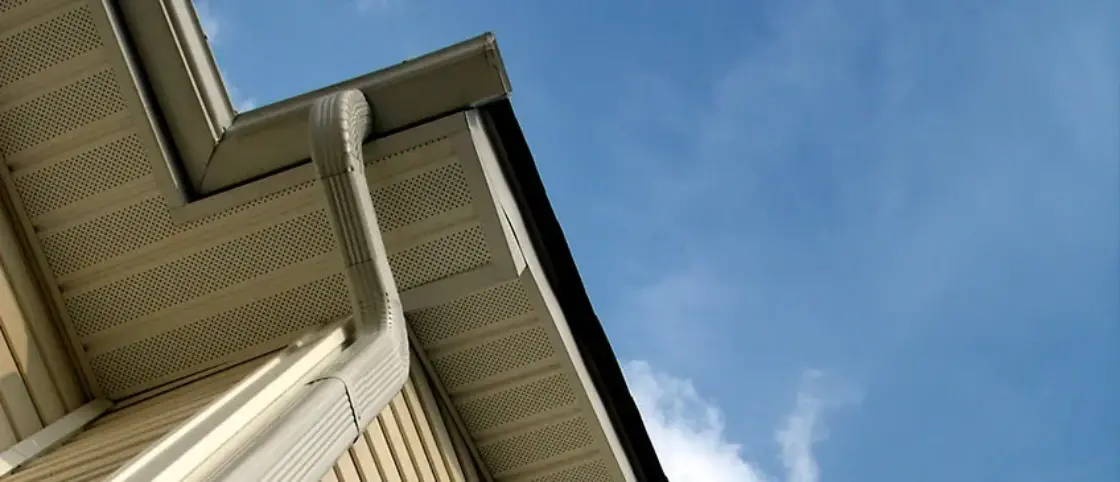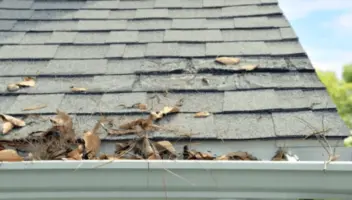5-inch vs 6-inch Gutters: Which Are Better?

While not every house will have them, the majority of homes need gutters. Why? Because they stop potential water damage by keeping rainfall away from vulnerable areas (such as your foundation) of your home. So a proper gutter system becomes an important piece of home maintenance.
If you’re installing new gutters or replacing old ones, you may wonder what size you need for your home (yes, there are multiple sizes!). Gutter sizes range from 4 to 7 inches with 5- and 6-inch options being the most popular. That said, bigger isn’t necessarily better. Each variation has its purpose, which means it’s up to the homeowner to decide what will be best for their unique situation.
In this article:
5-Inch Gutters
These are the most common types of gutters for the average home. In an area with less rainfall, five-inch gutters may work, but it also depends on the size of your roof and the pitch.
Features and Design
When choosing a gutter, you’ll generally decide from two common types: K-style and half-round. For 5-inch gutters, they can come in either style, though K-style is much more common than half-round.
Advantages of 5-Inch Gutters
- Easier installation: Since they are slightly smaller than the 6-inch gutters, a 5-inch gutter system (even with extra downspouts for every 40 feet of gutter run) is easier to install.
- Cost-effective: Per Bob Vila, gutters are priced by foot averaging between $3-$25 for the average K-style. Because they have less material, 5-inch gutters are more affordable than the 6-inch version.
Disadvantages of 5-Inch Gutters
- Limited water capacity: In the typical K-style, a 5-inch gutter can only hold 1.2 gallons of water per foot. This makes them unsuitable for places with a lot of rainfall per hour – not yearly.
- Not suitable for large roofs: This is a poor choice for larger roofs since 5-inch gutters clog more easily and have thinner downspouts resulting in more ongoing maintenance.
- Not suitable for roofs with steep pitch: A roof’s pitch determines how much windblown rain can collect in the gutters.
6-Inch Gutters
Slightly less common than the 5-inch gutter, the 6-inch gutter offers additional protection against heavy rainfall. For homeowners in areas known for heavy rainfall like Seattle, Fort Lauderdale or New Orleans, larger gutters in six or even seven inches are ideal.
Features and Design
Since they are larger, 6-inch gutters are better equipped for larger roofs, steeper pitches, and heavier rainfall. They utilize larger downspouts, too, which means there are fewer debris clogs for you to dig out by hand.
Advantages of 6-Inch Gutters
- More water capacity: 6-inch gutters can hold up to 50% more water than their 5-inch counterparts at 2 gallons per foot.
- More likely to protect roof fascia: If your home has smaller longboards that will surround the gutters, a 6-inch gutter can likely cover the entirety of your fascia board. The gutter then provides protection against rotting.
- Ideal for larger roofs: A larger roof means more water tumbling into the gutters during a rainstorm. Since a 6-inch gutter can withstand more water, it may be better for roofs that are 1,400 square feet and above.
Disadvantages of 6-Inch Gutters
- More expensive: Generally, 6-inch gutters will cost between $.50 and $1 more per foot than 5-inch gutters.
- More difficult to install: Since they are slightly heavier and require larger brackets, they can be harder to install.
5-in vs 6-in Gutters
Although there aren’t a lot of differences between them, understanding 5-inch vs 6-inch gutters could avoid a costly redo down the road.
Water Handling Capacity
5-inch gutters can only hold 1.2 gallons of water per foot but 6-inch gutters can hold 2 gallons.
Durability and Maintenance
With wider downspouts and more room for water flow, 6-inch gutters are less likely to clog than 5-inch gutters. That means less maintenance for the homeowner.
Cost Comparison
The cost of gutter installation can vary on things like the material and type of gutter – whether they are sectional or seamless. On average, a 5-inch gutter will cost $.50 to $1 less per foot than a 6-inch gutter.
on LeafFilter®
Choosing the Right Gutter Size
Whether you choose a 5-inch or 6-inch gutter depends on a handful of circumstances. Your home may even decide this for you.
- Roof Size and Steepness: The square footage of your roof can indicate a need for larger gutters because of how much rain runoff there is. However, the pitch of the roof or steepness also factors in. You can determine the steepness by dividing the height of the roof or its rise by the width.
- Local Weather Conditions: Desert or drier locations are less likely to need larger gutters. Areas with more rainfall will require more gutter space.
- Budget Constraints: Due to their size difference, 6-inch gutters are more expensive than 5-inch gutters.
Professional Advice and Assessment
Every home has its own unique requirements, especially when choosing between 5-inch and 6-inch gutters. Key considerations include roof size and pitch, local weather conditions, fascia board and downspout condition, and maintenance preferences. If damaged or too small, fascia boards and downspouts may need to be replaced.
“Hiring a professional to install your gutter guards takes this off the homeowner – the professional will ensure proper fit to make installation a smooth and easy process,” advises Chris Counahan, President at LeafFilter. A gutter specialist can assess your home’s needs and recommend the correct gutter size to manage water flow effectively, providing long-term durability and performance.
Before making any major gutter decisions, consider the current circumstances at your home. Is the fascia receiving water damage? Are you having a lot of clogging issues? Has there been a lot of heavy rainstorms recently?
When taking these questions into account, you may decide it’s time to replace your system with a larger one or, perhaps, even downsize.
Frequently asked questions
Is it better to have 5 or 6-inch gutters?
That depends on a few main things: your budget, the amount of local rainfall per hour, and your roof size.
Do larger gutters make a difference?
Absolutely! Larger gutters are less likely to clog and hold 50% more water than their 5-inch counterparts.
What size gutters are best?
Both the 5-inch and 6-inch gutters are best for their specific scenarios. For a smaller home in a drier area, for instance, the 5-inch gutters would be best because they don’t have to take on as much water.
Can I upgrade from a 5-inch to a 6-inch gutter without replacing my entire system?
Upgrading from a 5-inch to a 6-inch gutter without replacing your entire system is possible, but it can present challenges. The existing fascia boards and downspouts may need modifications to accommodate the larger gutters. Additionally, larger brackets may be necessary for a 6-inch gutter upgrade. Consult with a professional who can assess your current setup and determine the necessary adjustments.
What are the main differences between 5-inch and 6-inch gutters?
The main differences are that larger gutters can hold more water and protect exposed fascia, but are more expensive.


